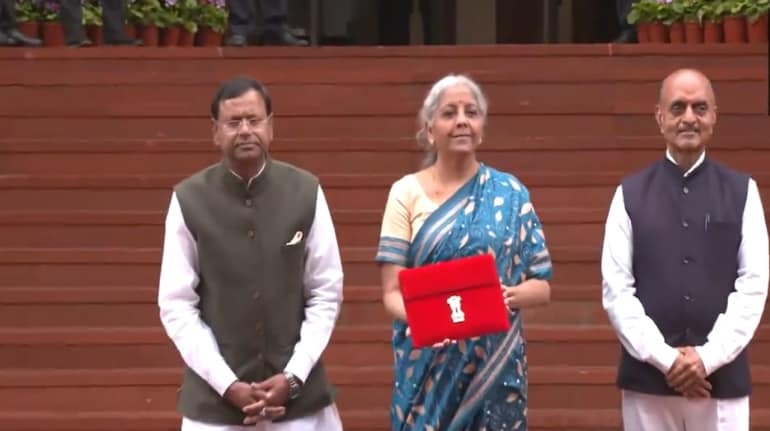
Stock market news, Share Market
The market is expected to open in the red as trends in SGX Nifty indicate a negative opening for the broader index in India with a loss of 24 points.
The BSE Sensex fell more than 350 points to 55,566 after rising more than 2,100 points in previous three straight sessions, while the Nifty50 declined 77 points to 16,584.5 and formed Inside Bar or Doji kind of pattern on the daily charts.
As per the pivot charts, the key support level for the Nifty is placed at 16,507, followed by 16,430. If the index moves up, the key resistance levels to watch out for are 16,676 and 16,768.
Stay tuned to Moneycontrol to find out what happens in the currency and equity markets today. We have collated a list of important headlines across news platforms which could impact Indian as well as international markets:
US Markets
Wall Street's three major indexes closed lower on Tuesday, following a rally last week, as volatile oil markets kept soaring inflation in focus and investors reacted to hawkish comments from a Federal Reserve official.
The Dow Jones Industrial Average fell 222.84 points, or 0.67 percent, to 32,990.12, the S&P 500 lost 26.09 points, or 0.63 percent, to 4,132.15 and the Nasdaq Composite dropped 49.74 points, or 0.41 percent, to 12,081.39.
Asian Markets
Shares in Asia-Pacific largely rose in Wednesday morning trade, with investors watching for market reaction to the release of a private survey on Chinese factory activity for May. Mainland Chinese stocks edged higher, with the Shanghai Composite rising 0.1 percent, while the Shenzhen Component was up fractionally. Hong Kong’s Hang Seng index slipped 0.12 percent.
The Nikkei 225 in Japan gained 0.62 percent, while the Topix index advanced 1.16 percent. In Australia, the S&P/ASX 200 climbed 0.23 percent.
SGX Nifty
Trends on SGX Nifty indicate a negative opening for the broader index in India with a loss of 24 points. The Nifty futures were trading around 16,535 levels on the Singaporean exchange.
Oil prices open higher on EU Russian oil ban, end of Shanghai lockdown
Oil prices rose in early Asian trade on Wednesday after European Union leaders agreed to a partial and phased ban on Russian oil and China ended its Covid-19 lockdown in Shanghai.
Brent crude for August delivery was up 78 cents, or 0.7 percent, at $116.38 a barrel at 0037 GMT. The front-month contract for July delivery expired on Tuesday at $122.84 a barrel, up 1 percent. US West Texas Intermediate (WTI) crude rose 63 cents, or 0.6 percent, to $115.30 a barrel. Both benchmarks ended the month of May higher, marking the sixth straight month of rising prices.
Government lowers FY22 GDP growth estimate to 8.7% as growth slides to 4.1% in Q4
India's GDP is estimated to have grown by 8.7 percent in FY22 after growth slid to 4.1 percent in January-March quarter (Q4FY22), data released on May 31 by the Ministry of Statistics and Programme Implementation showed.
Growth likely slowed down in the first quarter of the calendar year 2022 because of the hit to activity from the Omicron variant-led third COVID-19 wave and the Russia-Ukraine war. If the GDP for FY22 is compared to that of FY20 - before the pandemic hit the economy - the growth rate is a mere 1.5 percent.
Centre’s FY22 fiscal deficit at 6.7%, undershoots revised target by 20 bps
Indian central government’s fiscal deficit for FY22 has come in at 6.7 percent of Gross Domestic Product (GDP), undershooting the revised target of 6.9 percent, data released on May 31 by the Controller General of Accounts showed.
The fiscal deficit for FY22 was Rs 15.87 lakh crore - Rs 4,552 crore lower than the revised target of Rs 15.91 lakh crore.
While the FY22 fiscal deficit has come in lower than expected, the Centre's finances for FY23 have already taken a turn for the worse following the cut in excise duty on fuel products and other measures announced earlier this month by the finance ministry to contain elevated inflation.
India core sector growth quickens to 8.4% in April
India's eight core sectors grew 8.4 percent in April, quickening from a revised 4.9 percent in March, the commerce ministry said on May 31. Output in six of the eight core sectors grew in April. These sectors were coal, electricity, refinery products, fertilizers, cement, and natural gas.
The growth rate of the eight sectors during April-March 2021-2022 was 10.4 percent as compared to the corresponding period of the last financial year.
Eurozone inflation hits record 8.1% amid rising energy costs
Inflation in the 19 countries that use the euro currency hit a record 8.1 percent in May amid surging energy costs prompted in part by Russia’s war in Ukraine, authorities said Tuesday. Annual inflation in the eurozone soared past the previous record of 7.4 percent reached in March and April, according to the latest data from European Union statistics agency Eurostat.
FII and DII data
Foreign institutional investors (FIIs) have net sold Rs 1,003.56 crore worth of shares, whereas domestic institutional investors (DIIs) remained net buyers, to the tune of Rs 1,845.15 crore worth of shares on May 31, as per provisional data available on the NSE.
Gold hits near 2-week low as US bond yields, dollar firm
Gold prices hit a near two-week low on Wednesday, as rising Treasury yields and a strengthening US dollar continued to sap demand for greenback-priced bullion.
Spot gold was down 0.2 percent at $1,834.09 per ounce, as of 0044 GMT, its lowest since May 20. US gold futures fell 0.6 percent to $1,838.20.
With inputs from Reuters and other agenciesStock Market Today: Top 10 things to know before the market opens today - Moneycontrol
Read More


















